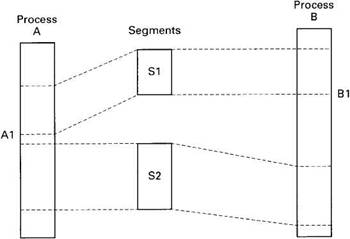Книга: Distributed operating systems
9.3.2. Mappers
9.3.2. Mappers
Chorus supports Mach-style external pagers, which are called mappers. Each mapper controls one or more segments that are mapped onto regions. A segment can be mapped into multiple regions, even in different address spaces at the same time, as shown in Fig. 9-11. Here segments S1 and S2 are both mapped into processes A and B, on the same machine but at different addresses. If process A writes address A1 it changes the first word of S1. If process B later reads B1 it also gets the value A wrote. Furthermore, if S1 is a file, when both processes terminate, the change will be made in the file on disk.
The virtual memory manager in each kernel maintains a page cache and keeps track of which page belongs to which segment. Pages in the local cache can belong to named segments, such as files, or to nameless segments, such as swap areas. The kernel keeps track of which pages are clean and which are dirty. It may discard clean pages at will, but must return dirty pages to the appropriate mappers to reclaim their space.
A protocol between the kernel and mapper determines the flow of pages in both directions. When a page fault occurs, the kernel checks to see if the needed page is cached. If it is not, the kernel sends a message to the mapper controlling the page's segment asking for the page (and possibly adjacent pages as well). The faulting thread is then suspended until the page arrives.
When the mapper gets the request, it checks to see if the needed page is in its own cache (in its own address space). If not, it sends a message to the thread managing the disk to perform I/O and fetch the page. When the page arrives (or if it was already present), the mapper notifies the kernel, which then accepts the page, adjusts the MMU page tables, and resumes the faulting thread.

Fig. 9-11. Segments can be mapped into multiple address spaces at the same time.
The mapper can also take the initiative and ask the kernel to return dirty pages to it. When the kernel returns them, the mapper can keep some of them in its own cache and write others to disk. Various calls are provided to allow the mapper to specify which pages it wants back. Most mappers do not keep track of how many page frames their segments are occupying since the kernel is free to discard clean pages and will return dirty pages to their mappers when space gets tight.
The same caching and management mechanism is used for pages that are part of mapped segments as for pages that are read and written using explicit segment I/O commands. This approach guarantees that if one process modifies a mapped page by writing on it, and immediately thereafter another process tries to read the file it is part of, the second process will get the new data, since only one copy of the page exists in memory.




